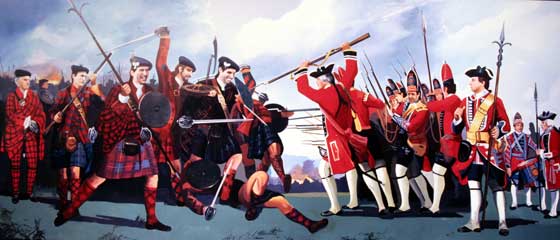 |
King's Own Royal Regiment Museum Lancaster |
||||||||||||||||
|
HOME Museum & Collections Soldiers of the Regiment Sales Donations Events Contact Us REGIMENTAL HISTORY 17th Century 18th Century 19th Century 20th Century First World War Second World War Actions & Movements Battle Honours FAMILY HISTORY Resources Further Reading PHOTO GALLERY ENQUIRIES FURTHER READING LINKS |
Regimental History - 18th Century In 1703 the regiment was placed on the Marine establishment, and took part in the capture of Gibraltar and the defence of the colony from October 1704 to May 1705. In 1710 the Regiment returned to the Army establishment. In 1715 the Regiment received the distinctive title The King's Own Regiment of Foot. As its name suggests, this was a regiment of foot soldiers - an infantry regiment. The Regiment was to see further changes in its title over the centuries. The Loyal and Friendly Society of the Blew and Orange was founded between 1733 and 1736 by officers of the King's Own Royal Regiment to commemorate the Revolution of 1688 and the accession of the House of Hanover to the English throne in 1714. James Thorne was Registrar of the Society and one of its wardens. The Society of the Blew and Orange is possibly the first ‘Regimental Association’ relating to the King’s Own. The Blew (the 18th Century spelling of blue) illustrated the Royal connection and the Orange illustrated the link with King William III (William of Orange). The Society had formal dinners four times per year, and the last recorded meeting was in 1801. As well as celebrating the Revolution and the Accession of the Hanoverians (1st August 1714), the Society also kept the anniversaries of the Battle of the Boyne (11 July) and the Battle of Culloden (16 April).
The Regiment was involved in the actions against the Jacobite rising under 'Bonnie Prince Charlie' 1745-46, and fought in the Battle of Culloden of April 1746. Indeed, the King's Own suffered more casualties on that day than any other Regiment. Lieutenant Colonel Robert Rich, commanding the battalion, lost his left hand and nearly lost his right arm in the battle.
Between 1753 and 1756 the King's Own were stationed on the Mediterranean island of Minorca. A pay document exists in the museum's collection with details the 'charge of the Garrison of Minorca' which also details the daily rates of pay for the officers and soldiers of the regiment.
In the second half of the 18th Century the King's Own saw active service in the West Indies and later in North America. Their first actions were against the French. This was part of continuing conflicts as European powers fought for control of the West Indian islands. The islands produced valuable goods for import - like rum and sugar. The American War of Independence, on the other hand, saw the struggle of thirteen North American colonies to win their independence from Britain. See uniforms of the period: © 2013 Trustees of the King's Own Royal Regiment Museum |


